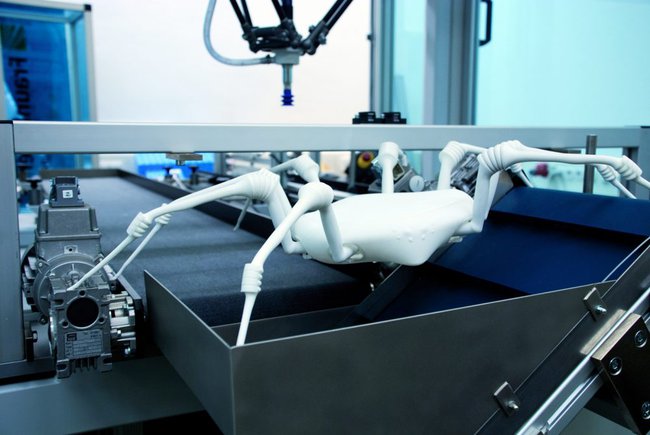Mother nature has perfected the biomechanics of everything from tiny leaf cells to whale fins over millennia, adapting their functions to be as efficient and effective as possible for each particular set of circumstances and environments. So it’s no surprise that designers, architects and engineers are taking cues from nature when they set out to create buildings, trains, prosthetics, robots and fashionable accessories. Check out these 9 cool examples of biomimicry in design and technology as well as our previous series: designs inspired by the sea, plants and insects.
Gecko Climbing Feet
How do geckos climb up vertical surfaces without falling off? The secret lies within tiny little hairs covering their toes. Researchers have managed to mimic the biomechanics of gecko feet in a pair of climbing pads capable of supporting a human’s weight. Each pad is covered with adhesive tiles bearing sawtooth-shaped polymer structures about the width of a human hair that create an adhesion force when they’re pulled on.
Kingfisher-Inspired Bullet Train
The fastest train in the world at speeds of up to 200 miles per hour, Japan’s Shinkansen Bullet Train was a marvel of modern technology. But there was one major problem after its initial debut: noise. Each time the train emerged from the tunnel, it caused a change in air pressure that caused thunder-like sounds that were a nuisance from a quarter of a mile away. The train’s chief engineer, a bird-watcher, had an idea: taking inspiration from the shape of a bird’s beak to make it more aerodynamic. The resulting design was based on the narrow profile of a kingfisher’s beak, resulting in a quieter train that also consumes 15% less electricity and goes 10% faster than before.
Baobab Tree Inspired Treehouses
The beautiful Embryo Treehouse by Antony Gibbon Designs aims to look like a part of the tree that it uses for support, wrapping around the trunk like a natural growth. The shape of this beautiful treehouse closely resembles that of the baobab tree, which has a massive, swollen-looking trunk. Not only does it honor nature in its appearance, it also has a very small impact on its forest environment, attaching with a set of braces so the tree can continue to grow.
Armadillo Backpack
The hide of an armadillo is rigid yet flexible, offering protection but enabling the animals to remain nimble. This backpack from Cylus and others in the Pangolin collection take cues from the scaled mammals of the Manidae family, joining sections of recycled rubber inner tubes around a central axis to make them durable and adaptable.
Survivor-Locating Spider
The ability to squeeze through tight spaces and turn on a dime makes the spider an ideal model for lifesaving robots that could make their way through rubble after a disaster to locate survivors. Normally, seeing a gigantic arthropod making its way toward you would be terrifying, but in this case, it would be a relief. Researchers at Germany’s Frauenhofer Institute say this robot can be cheaply reproduced using 3D printers. “This high-tech assistant is still a prototype, but future plans envision its use as an exploratory tool in environments that are too hazardous for humans, or too difficult to get to. After natural catastrophes and industrial or reactor accidents, or in fire department sorties, it can help responders, for instance by broadcasting live images or tracking down hazards or leaking gas.”
Biomimicry Heliotrope Follows the Movements of the Sun
Did you know that sunflowers turn themselves throughout the day to follow the movement of the sun? This lighting device by designer Jonathan Ota copies that phenomenon with silvery artificial flowers with LED light bulbs in the center. Powered by solar panels, the flowers are fitted with tiny pistons that use evaporation of alcohol to move the petals, closing them up during the day and opening them at night.
Tree-Climbing Robot Mimics Inch Worms
The Treebot uses tactile sensors to find its way up a tree trunk in the same way that inchworms do, feeling around to determine where it should grasp for the best grip. It can even haul loads up sharply inclined branches. Say the creators, “The objective of the development of Treebot is to assist or replace human being in performing forestry tasks on trees. Although the information obtained by tactile sensors is not rich, it is reliable. Furthermore, the processing of tactile information is much simpler than that of visual information.”
Bird Skull Shoe by Mariek Ratsma
The aesthetics and shape of a bird skull inspired this highly unusual, lightweight, sculptural shoe design by Mariek Ratsma. The Dutch designer collaborated with architect Kostika Spaho to create ‘Biomimicry Shoe,’ which offers lots of support with less material for “optimal efficiency, strength and elegance.”
Tentacle-Inspired Prosthetic Arm
Why would a prosthetic arm for humans take its shape from the appendage of another creature? For Kaylene Kau, designer of this fascinating concept, it comes down to study of the way prosthetics are actually used. Says Kau, “Through extensive research I found that the prosthetic functioned as an assistant to the dominant functioning hand. The prosthetic needed to be both flexible and adjustable in order to accommodate a variety of different grips.” Tentacles provided an ideal model, gripping objects with a simple curling motion.


